Minerals
A mineral is a naturally occurring inorganic solid with a specific chemical composition and a crystalline structure. Minerals are the building blocks of rocks, and they have various physical properties that can be used for identification.
Properties of Minerals
Minerals have several distinguishing physical properties:
- Color: The color of a mineral can vary, but it is not always a reliable indicator for identification.
- Luster: This refers to the way light reflects off the surface of a mineral. Common types of luster include metallic, glassy, and dull.
- Hardness: The Mohs scale is used to measure the hardness of minerals, ranging from 1 (softest, like talc) to 10 (hardest, like diamond).
- Streak: The color of the powdered form of a mineral, which can differ from the color of the mineral itself.
- Cleavage and Fracture: Cleavage is the way a mineral breaks along flat surfaces, while fracture refers to irregular or uneven breaks.
- Crystal Habit: The natural shape in which a mineral tends to grow.
Formation of Minerals
Minerals are formed through various geological processes, including:
- Crystallization from Magma: Minerals can form as magma cools and solidifies, resulting in the formation of igneous rocks.
- Precipitation: Minerals can precipitate out of solutions, such as when water evaporates and leaves behind mineral deposits.
- Metamorphism: Changes in temperature and pressure can cause existing minerals to recrystallize and form new minerals.
Common Minerals
There are thousands of identified minerals, but some of the most common ones include:
- Quartz: A hard mineral often found in igneous and metamorphic rocks.
- Feldspar: A group of minerals that are the most abundant in the Earth's crust.
- Mica: Known for its perfect cleavage and ability to split into thin, transparent sheets.
- Calcite: A major component of limestone and marble, with a characteristic rhombohedral cleavage.
- Halite: Commonly known as rock salt, often forming in evaporite deposits.
Study Guide
Here are some key points to remember when studying minerals:
- Understand the definition of a mineral and its essential characteristics.
- Learn to identify minerals based on their physical properties, such as color, luster, hardness, and cleavage.
- Be familiar with the processes of mineral formation, including crystallization from magma, precipitation, and metamorphism.
- Memorize the properties and common examples of important minerals like quartz, feldspar, mica, calcite, and halite.
Remember to practice identifying minerals using their physical properties and study the specific characteristics of common minerals to deepen your understanding of this topic.
.◂Science Worksheets and Study Guides Fourth Grade. Rocks and minerals
Study Guide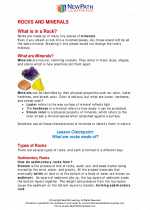 Rocks and minerals
Rocks and minerals  Activity Lesson
Activity Lesson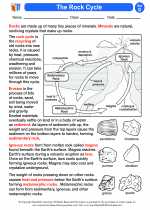 The Rock Cycle
The Rock Cycle  Worksheet/Answer key
Worksheet/Answer key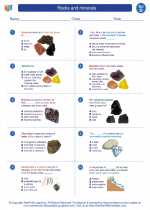 Rocks and minerals
Rocks and minerals  Worksheet/Answer key
Worksheet/Answer key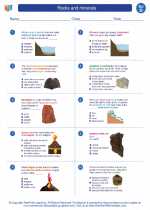 Rocks and minerals
Rocks and minerals  Worksheet/Answer key
Worksheet/Answer key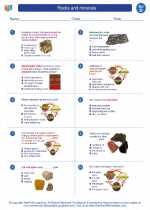 Rocks and minerals
Rocks and minerals  Worksheet/Answer key
Worksheet/Answer key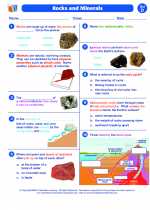 Rocks and Minerals
Rocks and Minerals  Vocabulary/Answer key
Vocabulary/Answer key Rocks and minerals
Rocks and minerals  Vocabulary/Answer key
Vocabulary/Answer key Rocks and minerals
Rocks and minerals  Vocabulary/Answer key
Vocabulary/Answer key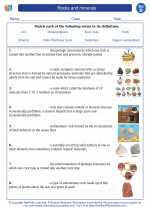 Rocks and minerals
Rocks and minerals  Vocabulary/Answer key
Vocabulary/Answer key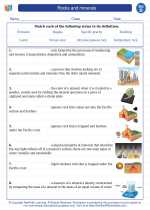 Rocks and minerals
Rocks and minerals 

 Activity Lesson
Activity Lesson
 Worksheet/Answer key
Worksheet/Answer key
 Worksheet/Answer key
Worksheet/Answer key
 Worksheet/Answer key
Worksheet/Answer key
 Worksheet/Answer key
Worksheet/Answer key
 Vocabulary/Answer key
Vocabulary/Answer key
 Vocabulary/Answer key
Vocabulary/Answer key
 Vocabulary/Answer key
Vocabulary/Answer key
 Vocabulary/Answer key
Vocabulary/Answer key

The resources above cover the following skills:
Concepts of Earth Science (SD1, SD2, SD3, SD4)
The student demonstrates an understanding of geochemical cycles by describing that most smaller rocks come from the breaking and weathering of larger rocks as part of the rock cycle.
The student demonstrates an understanding of geochemical cycles by recognizing the physical properties of water as they relate to the rock cycle.